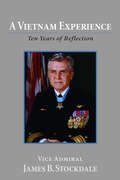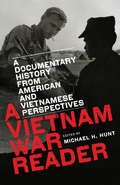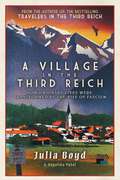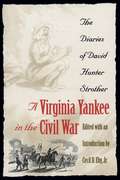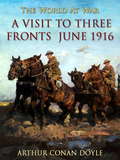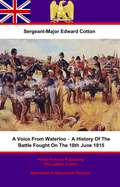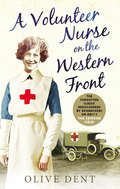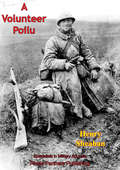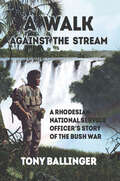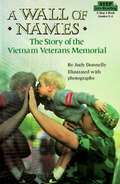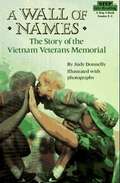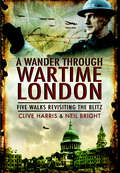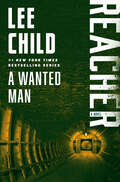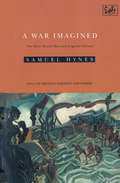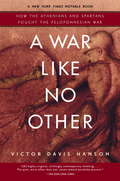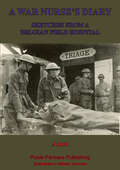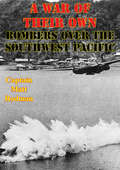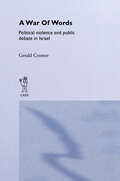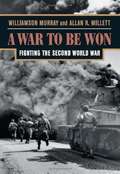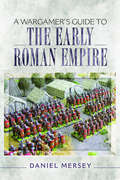- Table View
- List View
A Vietnam Experience: Ten Years of Reflection
by James B. StockdaleThe decade that followed James Stockdale's seven and a half years in a North Vietnamese prison saw his life take a number of different turns, from a stay in a navy hospital in San Diego to president of a civilian college to his appointment as a senior research fellow at the Hoover Institution. In this collection of essays he offers his thoughts on his imprisonment. Describing the horrors of his treatment as a prisoner of war, Stockdale tells how he discovered firsthand the capabilities and limitations of the human spirit in such a situation. As the senior officer in confinement he had what he humbly describes as "the easiest leadership job in the world: to maintain the organization, resistance, and spirit of ten of the finest men I have ever known." His reflections on his wartime prison experience and the reasons for his survival form the basis of the writings reprinted here. In subject matter ranging from methods of communication in prison to military ethics to the principles of leadership, the thirty-four selections contained in this volume are a unique record of what Stockdale calls a "melting experience"—a pressure-packed existence that forces one to grow. Retired Vice Admiral James B. Stockdale, a Hoover Institution fellow from 1981 to 1996, was Ross Perot's 1992 presidential running mate and a recipient of the Medal of Honor after enduring seven and a half years as a prisoner of war in North Vietnam. He died in 2005 at the age of 81.
A Vietnam War Reader
by Michael H. HuntAn essential new resource for students and teachers of the Vietnam War, this concise collection of primary sources opens a valuable window on an extraordinarily complex conflict. The materials gathered here, from both the American and Vietnamese sides, remind readers that the conflict touched the lives of many people in a wide range of social and political situations and spanned a good deal more time than the decade of direct U.S. combat. Indeed, the U.S. war was but one phase in a string of conflicts that varied significantly in character and geography. Michael Hunt brings together the views of the conflict's disparate players--from Communist leaders, Vietnamese peasants, Saigon loyalists, and North Vietnamese soldiers to U.S. policymakers, soldiers, and critics of the war. By allowing the participants to speak, this volume encourages readers to formulate their own historically grounded understanding of a still controversial struggle.
A View from the Stands
by John Kenneth GalbraithIn the decades since World War II, no American writer has done more to comfort the afflicted and afflict the comfortable than John Kenneth Galbraith. Galbraith reflects on many famous people, including Mencken, Hemingway, O'Hara, Muggeridge, Buckley, and more.
A Village in the Third Reich: How Ordinary Lives Were Transformed by the Rise of Fascism
by Julia Boyd Angelika PatelAn intimate portrait of German life during World War II, shining a light on ordinary people living in a picturesque Bavarian village under Nazi rule, from a past winner of the Los Angeles Times Book Prize for History.Hidden deep in the Bavarian mountains lies the picturesque village of Oberstdorf—a place where for hundreds of years people lived simple lives while history was made elsewhere. Yet even this remote idyll could not escape the brutal iron grip of the Nazi regime. From the author of the international bestseller Travelers in the Third Reich comes A Village in the Third Reich, shining a light on the lives of ordinary people. Drawing on personal archives, letters, interviews and memoirs, it lays bare their brutality and love; courage and weakness; action, apathy and grief; hope, pain, joy, and despair. Within its pages we encounter people from all walks of life – foresters, priests, farmers and nuns; innkeepers, Nazi officials, veterans and party members; village councillors, mountaineers, socialists, slave labourers, schoolchildren, tourists and aristocrats. We meet the Jews who survived – and those who didn&’t; the Nazi mayor who tried to shield those persecuted by the regime; and a blind boy whose life was judged "not worth living." This is a tale of conflicting loyalties and desires, of shattered dreams—but one in which, ultimately, human resilience triumphs. These are the stories of ordinary lives at the crossroads of history.
A Virginia Yankee in the Civil War
by Cecil D. EbyThe Civil War diaries of David Hunter Strother, known better to his contemporaries as "Porte Crayon," chronicle his three years of service in the Union army with the same cogency and eye for detail that made him one of the most popular writers and illustrators in America in his time. A Virginian strongly opposed to secession, Strother joined the Federal army as a civilian topographer in July of 1861 and was soon commissioned, rising eventually to the rank of brigadier general. He served under a succession of commanders, including Generals Patterson, Banks, Pope, and McClellan, winning their respect as well as their confidence. First published by UNC Press in 1961, A Virginia Yankee in the Civil War is a fascinating firsthand record of the conflict and of the divided loyalties it produced that is further enlivened by Strother's remarkable humor and insight.
A Visit to Three Fronts June 1916: June 1916 (world Classics, Unabridged) (The World At War)
by Arthur DoyleThe book is a glorious effort on the part of the author to record the impressions that he formed during his visit to the fronts of the Western Allies during World War I. The book was written in appreciation of the valiant and bold soldiers who fought for their countrymen and whose efforts were being belittled due to increasing rumours. (Excerpt from Goodreads)
A Visitor's Guide to Jane Austen's England (A Visitor's Guide #2)
by Sue Wilkes&“Wilkes makes the world of Jane Austen come to life . . . from travel to fashion, shopping, leisure, and, of course, finding a mate&” (Britain Express). Immerse yourself in the vanished world inhabited by Austen&’s contemporaries. Packed with detail and anecdotes, this is an intimate exploration of how the middle and upper classes lived from 1775, the year of Austen&’s birth, to the coronation of George IV in 1820. Sue Wilkes skillfully conjures up all aspects of daily life within the period, drawing on contemporary diaries, illustrations, letters, novels, travel literature, and archives. Were all unmarried affluent men really &“in want of a wife&”?Where would a young lady seek adventure?Would &“taking the waters&” at Bath and other spas kill or cure you?Was Lizzy Bennet bitten by bed-bugs while traveling?What would you wear to a country ball or a dance at Almack&’s?Would Mr. Darcy have worn a corset?What hidden horrors lurked in elegant Regency houses? &“A delight. I don&’t think I&’ve ever read a book that paints such a vivid picture of daily life in late 18th and early 19th century England. It makes a perfect companion for Austen&’s beloved novels.&” —The Heritage Traveller &“A thoroughly engaging—and very informative—&‘eyewitness&’ guide to everything from medical matters to modes of travel.&” —Joceline Bury, Jane Austen&’s Regency World &“Written as if to a first-time traveler in the Regency . . . an inviting read . . . a perfect gift for every Janeite friend and family member.&” —Austenprose &“A worthy contribution to the field of Austen social history and uses the mundane realities of life to illuminate the reader&’s experience.&” —Sensibilities
A Voice From Harper's Ferry
by Osbourne P. AndersonA unique book from the 1859 raid on Harper's Ferry, this firsthand account of the only black combatant to survive the raid details the story of this turning point in the struggle against slavery and refutes the notion that African American people did take on the cause for their freedom.-Print ed.“Osborne Perry Anderson was born on this date in 1830. He was a Black abolitionist.From in West Fallow Field, Pennsylvania, Anderson along with John Anthony Copeland Jr., attended Oberlin College in Oberlin, Ohio. He later moved to Chatham, Canada, where he worked as a printer for Mary Ann Shadd's newspaper, The Provincial Freeman. In 1858 Anderson met John Brown and eventually became persuaded to join his band of men determined to attack Harpers Ferry. He was one of the five Black men to accompany John Brown in the raid on the Federal Arsenal at Harpers Ferry, Virginia (now West Virginia) in October 1859. This was Brown’s radical scheme to free the United States of slavery.Like Brown and the other followers, Anderson believed that if the group seized weapons at Harpers Ferry and then marched south, they would create a massive slave uprising that would liberate all of the nearly four million African Americans in bondage. He was the only Black to escape capture. In 1861 Anderson, now safely in the North, wrote A Voice From Harper’s Ferry with assistance from Mary Ann Shadd.Here he described his role in the raid and argued that many local slaves would have welcomed their liberation and some in fact had helped Brown and his men. Anderson's account was the only one published by a member of Brown's party and provided a rare first hand description of the events and the motivation of these abolitionists. In 1864, five years after the Harpers Ferry Raid, Anderson enlisted in the Union Army, serving as a recruitment officer in Indiana and Arkansas.Osborne Anderson died on December 13, 1872 in Washington, D.C. at the age of forty-two.”-AAREG
A Voice From Waterloo – A History Of The Battle Fought On The 18th June 1815
by Sergeant-Major Edward CottonThis ebook is purpose built and is proof-read and re-type set from the original to provide an outstanding experience of reflowing text for an ebook reader. Sergeant-Major Cotton retired from the British army after long and hard service that saw him fight in numerous engagements and battles, none more memorable than his last, that of Waterloo. During the battle he was orderly to Maj-General Sir Hussey Vivian commanding 6th British cavalry brigade. Thankfully a new, less dangerous, and more lucrative trade opened up to him, that of battlefield guide. This trade still lives on in and around the battlefield, after many years Cotton knew the history of the campaign in minute detail, not however missing updating his knowledge with the books published from time to time such as Beamish's History of the King's German Legion and Siborne's History. Having fought on and spent so much time in and around the battlefield steeped in the history of the epoch defining battle, Cotton stood uniquely placed to add to the blossoming Waterloo book trade and add his own incomparable story. His book is well researched, interesting and is the source for a great many of the anecdotes that have been lifted for other books on the subject. An excellent addition to the eye-witness accounts, flavoured with a lifetimes knowledge of the battlefield and the original source documents which he uses especially as indexes. Author - Sergeant-Major Edward Cotton, formerly of the 7th Hussars (1792?-1849) Text taken, whole and complete, from the third edition published in 1854, London, B. L. Green and Principal Booksellers in Belgium Original - 276 pages. Portraits and Illustrations - 11 included MAPS - due to their size have not been included [1 A3] Linked TOC - in keeping with the format of the times that the book was published the table of contents includes the summary notes of each chapter.
A Volunteer Nurse on the Western Front: Memoirs from a WWI camp hospital
by Olive DentStarring Oona Chaplin as a V.A.D. (Voluntary Aid Detachment), and Suranne Jones and Hermione Norris as trained nurses, The Crimson Field is a gripping drama set in a tented hospital on the coast of France, where plucky real-life V.A.D. Olive Dent served two years of the Great War, and kept this extraordinarily vivid diary of day-to-day life – ever cheerful through the bitter cold, the chilblains, hunger and exhaustion. Resilient, courageous and resourceful, nurses, doctors and patients alike do their best to support each other. A Christmas fancy-dress ball, a concert performed by a stoic orchestra covered in bandages, church services held in a marquee and letters from Blighty all keep spirits up in camp, as wounded soldiers suffer terribly with quiet dignity on the makeshift wards, and nurses rush round tirelessly to make them as comfortable as possible.With original illustrations throughout by fellow V.A.D.s, Olive’s memoir is a fascinating period piece, a rare first-hand account of this little-known story, which will resonate very strongly with viewers of The Crimson Field.
A Volunteer Poilu [Illustrated Edition]
by Henry Beston SheahanIllustrated with a number of photographs from the French Front Lines in and around Verdun. Also Includes The Americans in the First World War Illustration Pack - 57 photos/illustrations and 10 maps.Henry Beston Sheahan was a noted American novelist and naturist who wrote many well-known books, including the Cape Cod classic The Outermost House; he volunteered for service in the French Army during the First World War. In volunteer Poilu he recounts his experiences in the American Ambulance Service in the evacuating casualties in and around Verdun during 1916. In the midst of the bloodiest prolonged siege in the world at that time the number of wounded French soldiers were prodigious; the Ambulance services needed every able body even if they did come from the neutral United States. In spite of the huge workload that Sheahan undertook he managed to scribble notes of scenes and anecdotes of the great battle and the soldiers of the French Army.A rare and movingly written memoir from the Great Battle of Verdun.
A Walk Against The Stream: A Rhodesian National Service Officer's Story of the Bush War
by Tony BallingerThe experiences of a young soldier on the frontlines of the Rhodesian Bush War are vividly recounted in this personal memoir.In A Walk Against the Stream, Tony Ballinger tells of his eighteen months of compulsory service as a young national service officer in the Rhodesian army. Stationed in Victoria Falls, Rhodesia, he faced down enemy territory just across the Zambezi river in Zambia.Initially allocated to 4th platoon, 4 Independent company Rhodesia Regiment (RR) as a subaltern and later on as a 1st Lieutenant in support company 2RR, the story starts with the author’s training and deployment. The events that unfold contain interesting military encounters, including battles against the Zambian army and revolutionary guerillas.But Ballinger also explores the human side of his time in the service: his love of a country falling apart, the relationship he forms with a local woman; and how their love, hope and dreams are snatched away by unfolding events. This is a riveting personal tale, interspersed with dozens of the author’s personal photographs.
A Wall Of Names: The Story Of The Vietnam Veterans Memorial
by Judy DonnellyStep into Reading with A WALL OF NAMES: The Story of the Vietnam Veterans Memorial "Why did you die and not me?" This is a note to a dead soldier from an old friend. It is one of hundreds of notes left every year beside the Vietnam Veterans Memorial -- a wall curved with the names of all the US soldiers who died in the Vietnam War. The wall was built to honor these men and women and to heal the deep wounds left by the longest and most hated war ever fought by Americans. Here's the dramatic story of how the wall came to be and what Vietnam meant to our country in the war-torn years of the 60s. Select picture descriptions added and captions
A Wall of Names: The Story of the Vietnam Veterans Memorial
by Judy DonnellySurveys the history of the Vietnam War, chronicles the construction of the Vietnam Memorial, and discusses what the Memorial means to many Americans.
A Wander Through Wartime London: Five Walks Revisiting the Blitz
by Clive Harris Neil BrightThrough a series of five walks this book discovers the sights, sounds and experience of the capital at war; it details the remaining tangible evidence of the dark days via air raid shelter signs, bomb damage on buildings and memorials detailing heroic and often tragic events. The new routes cover a wide area of London and reveal further evidence of the experiences of four years air war in the skies above our capital city. The East End & Docks, Greenwich, Holborn, Bermondsey, Southwark and the West End are all featured, along with detailed maps and numerous contemporary photographs that accompany the text for each walk. The book also contains a number of appendices relating to the wider picture of the war. A well deserved story of Londons Home Guard is told. A list of Civil Defense casualties that occurred within the boroughs covered by the walks is included as well as a detailed list of the locations of wartime fire and ambulance stations across the capital.This book will appeal to both the enthusiast and anyone with an interest in Londons past. It is a further record of the memories and tangible evidence of this dramatic period of our capitals past and a tribute to those who lived through the Blitz and sadly so often, those who did not.
A Wanted Man: A Jack Reacher Novel (Jack Reacher #17)
by Lee Child#1 NEW YORK TIMES BESTSELLER • Don&’t miss the hit streaming series Reacher!&“The indomitable Reacher burns up the pages.&”—USA TodayFour people in a car, hoping to make Chicago by morning. One man driving, another telling stories that don&’t add up. A woman in the back, silent and worried. And a hitchhiker with a broken nose. An hour behind them, the FBI descends on an old pumping station where a man was stabbed to death—the knife work professional, the killers nowhere to be seen.All Jack Reacher wanted was a ride to Virginia. All he did was stick out his thumb. But he soon discovers he has hitched more than a ride. He has tied himself to a massive conspiracy, in which nothing is what it seems, and nobody is telling the truth.&“Furious action . . . [Lee] Child keeps the pacing swift and the surprises rolling. . . . [A] feverishly thrilling series.&”—The Miami Herald&“Smart, breathless . . . [with] one of the best female characters in the whole Reacher series.&”—The New York Times&“Subtle and nuanced [with] seductive writing and irresistible plot twists.&”—Newsweek
A War Imagined: The First World War and English Culture
by Samuel HynesBetween the opulent Edwardian years and the 1920s the First World War opens like a gap in time. England after the war was a different place; the arts were different; history was different; sex, society, class were all different.Samuel Hynes examines the process of that transformation. He explores a vast cultural mosaic comprising novels and poetry, music and theatre, journalism, paintings, films, parliamentary debates, public monuments, sartorial fashions, personal diaries and letters.Told in rich detail, this penetrating account shatters much of the received wisdom about the First World War. It shows how English culture adapted itself to the needs of killing, how our stereotypes of the war gradually took shape and how the nations thought and imagination were profoundly and irretrievably changed.
A War Like No Other: How the Athenians and Spartans Fought the Peloponnesian War
by Victor HansonOne of our most provocative military historians, Victor Davis Hanson has given us painstakingly researched and pathbreaking accounts of wars ranging from classical antiquity to the twenty-first century. Now he juxtaposes an ancient conflict with our most urgent modern concerns to create his most engrossing work to date, A War Like No Other.Over the course of a generation, the Hellenic city-states of Athens and Sparta fought a bloody conflict that resulted in the collapse of Athens and the end of its golden age. Thucydides wrote the standard history of the Peloponnesian War, which has given readers throughout the ages a vivid and authoritative narrative. But Hanson offers readers something new: a complete chronological account that reflects the political background of the time, the strategic thinking of the combatants, the misery of battle in multifaceted theaters, and important insight into how these events echo in the present.Hanson compellingly portrays the ways Athens and Sparta fought on land and sea, in city and countryside, and details their employment of the full scope of conventional and nonconventional tactics, from sieges to targeted assassinations, torture, and terrorism. He also assesses the crucial roles played by warriors such as Pericles and Lysander, artists, among them Aristophanes, and thinkers including Sophocles and Plato.Hanson's perceptive analysis of events and personalities raises many thought-provoking questions: Were Athens and Sparta like America and Russia, two superpowers battling to the death? Is the Peloponnesian War echoed in the endless, frustrating conflicts of Vietnam, Northern Ireland, and the current Middle East? Or was it more like America's own Civil War, a brutal rift that rent the fabric of a glorious society, or even this century's "red state--blue state" schism between liberals and conservatives, a cultural war that manifestly controls military policies? Hanson daringly brings the facts to life and unearths the often surprising ways in which the past informs the present.Brilliantly researched, dynamically written, A War Like No Other is like no other history of this important war.
A War Minister And His Work: Reminiscences Of 1914-1918 [Illustrated Edition]
by General Hermann Von SteinIncludes the First World War Illustrations Pack - 73 battle plans and diagrams and 198 photosEven before the advent of the First World War, General Der Artillerie Hermann Von Stein, had had a long and distinguished career in the Prussian Army stretching back to 1873. He served in various artillery and staff posts and rubbed shoulders with the heads of the General Staff such as Von Schlieffen, both Von Moltkes and Von Waldersee (of whom he includes portraits in this volume). In 1914 he was appointed to the 14th Reserve Corps which advanced with 2nd Army as part of the right hook through northern France before being bogged down in the stalemate of the trenches of the Western Front. He and his men were those who stubbornly defended Thiepval during the bloody battle of the Somme in 1916. After his successful field commands he was appointed War Minister for Prussia, a post that he held until the end of the war. His reminiscences offer a little seen view of the German High Command during the First World War.
A War Nurse’s Diary; Sketches From A Belgian Field Hospital [Illustrated Edition]
by Anon.Illustrated with 33 photos of the author's comrades, adventures and hospitals.When war broke out in 1914, it was imagined in Britain that the war with Germany would be short and the need for nursing staff over in France would be low as there should be very few casualties. The author, a trained nurse from the Northern Midlands in England, decided that she would volunteer her services immediately, but was rebuffed by the Red Cross and St John's Ambulance on the basis that they had almost one nurse for every soldier in the field. Not to be deterred, she responded to an advert which read: "Ten nurses wanted at once for Antwerp; must be voluntary." And off to Belgium she went in August 1914.It was to be in Belgium that so many of these rosy presumptions that were held by many were shattered early in the autumn of 1914, as the German steamroller thumped into the Allied forces. In its wake the huge numbers of wounded flooded into the hospitals in Belgium where our author was inundated with work. As the Germans moved forward, she and her fellow hospital staff were moved backward from Antwerp, where she was briefly caught up in the siege, escaping to Ghent, Bruges, Ostend and thence to France. She tended to the wounded amidst the carnage of war almost unceasingly until a year later when she left France for England in October 1915.
A War of Their Own: Bombers Over the Southwest Pacific [Illustrated Edition]
by Captain Matt Rodman[Illustrated with more than 45 diagrams, photos and tables]Captain Rodman, an instructor weapon-systems officer at Dyess AFB, Texas, examines the distinctive nature of Fifth Air Force's role in the air war over the Southwest Pacific Area during World War II. Especially notable is Gen George Kenney's innovative use of light attack aircraft as well as both medium and heavy bombardment aircraft, characterized by theater-specific tactics, ordnance, and structural modifications. A War of Their Own also considers the free exchange of aircraft and missions in the Southwest Pacific a hallmark of that theater; in terms of the conflict between doctrine and tactics that underlay Fifth Air Force's relationship to the prewar Army Air Corps and the postwar Air Force. The author also notes the relevance of the Fifth's experiences to airpower.
A War of Words: Political Violence and Public Debate in Israel (Political Violence Ser.)
by Gerald CromerThis book examines a series of controversies surrounding Israel's use of force and its failure to prevent violence. Influenced by Weber's definition of the state as the 'monopoly of violence', politcial scientists and criminologists alike have focused their attention on the legitimation struggles of non-state actors who resort to violence. This boo
A War to be Won: Fighting the Second World War
by Williamson Murray Allan R. MillettIn the course of the twentieth century, no war looms as profoundly transformative or as destructive as World War II. Its global scope and human toll reveal the true face of modern, industrialized warfare. Now, for the first time, we have a comprehensive, single-volume account of how and why this global conflict evolved as it did. A War To Be Won is a unique and powerful operational history of the Second World War that tells the full story of battle on land, on sea, and in the air. Williamson Murray and Allan R. Millett analyze the operations and tactics that defined the conduct of the war in both the European and Pacific Theaters. Moving between the war room and the battlefield, we see how strategies were crafted and revised, and how the multitudes of combat troops struggled to discharge their orders. The authors present incisive portraits of the military leaders, on both sides of the struggle, demonstrating the ambiguities they faced, the opportunities they took, and those they missed. Throughout, we see the relationship between the actual operations of the war and their political and moral implications. A War To Be Won is the culmination of decades of research by two of America's premier military historians. It avoids a celebratory view of the war but preserves a profound respect for the problems the Allies faced and overcame as well as a realistic assessment of the Axis accomplishments and failures. It is the essential military history of World War II-from the Sino-Japanese War in 1937 to the surrender of Japan in 1945-for students, scholars, and general readers alike.
A Wargamer's Guide to the Early Roman Empire
by Daniel MerseyThe Roman army of the early empire is one of the most instantly recognizable armies and enjoys a reputation for excellence. This and their many famous campaigns against a wide range of colorful foes makes this one of the most popular periods for wargamers. Covering the period from 27BC to AD284, Daniel Mersey gives a wargamers perspective of the many conflicts and offers advice on how to recreate these on the gaming table. Advice is given on factors to consider when choosing an appropriate set of commercially available rules, or devising your own, to best suit the scale and style of battle you want and capture the flavor of the period. The relevant ranges of figures and terrain pieces and buildings are also reviewed. Analysis of the forces involved, organization, tactics and strategies will help with building your armies and there are interesting scenarios included. Whether this is a new period for you, or you are looking to refresh your existing interest in the period, this handy guide is sure to hold much if interest.
A Warriner to Rescue Her: The Wild Warriners (The Wild Warriners #2)
by Virginia HeathA wounded war veteran tries to resist falling for the minister’s daughter in this Regency romance.Tempted by the damsel in distress! Captain James Warriner is startled to find a curvaceous beauty caught up a tree in his orchard! Despite his shattered leg, he rescues Miss Cassandra Reeves, then is determined to have nothing more to do with the enticing vicar’s daughter. Except when Cassie seeks Jamie out to apologize, they find themselves persuaded to work together on her storybook. Secret liaisons with the dashing soldier make Cassie wish Jamie would rescue her once more . . . by making her his wife!
